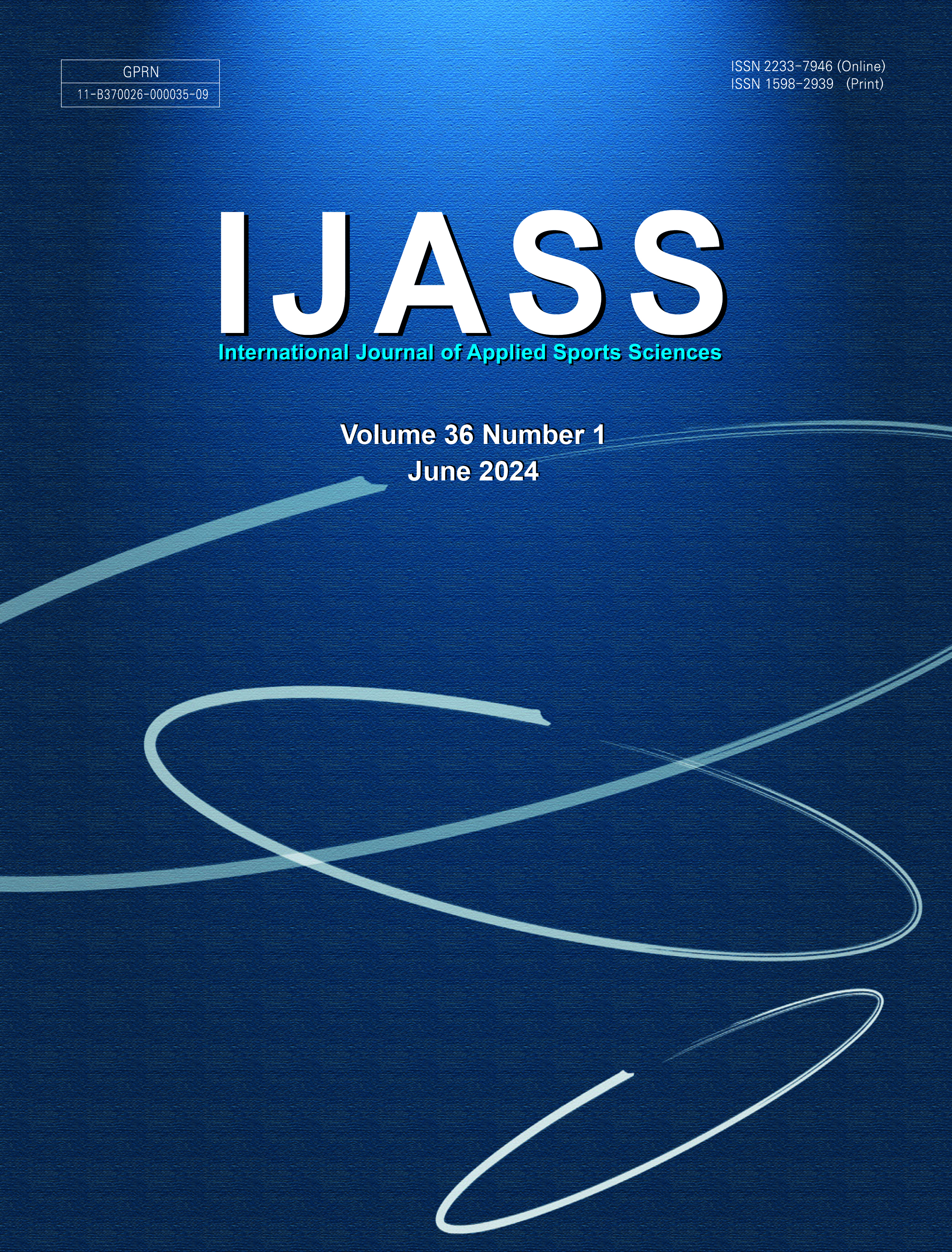 ISSN : 1598-2939
ISSN : 1598-2939

This study examined the effects of an eight-week neuromuscular training (NMT) program on knee valgus angle in African American female athletes. Twenty-six female collegiate athletes participated. NMT group (n=15, 19.6±1.12 years) underwent an intervention training program that included three main components (plyometric and movement, core strengthening and balance, and resistance training). While, control group (n=11, 19.3±1.50 years) underwent the resistance training protocol for eight weeks. We hypothesized the NMT program would significantly decrease knee valgus angles during a drop vertical jump (DVJ) at landing for the NMT group when compared to the control group. Wilcoxon signed rank tests were done on the Pre-and Post-test findings. Results showed maximum valgus angle (VGmax) is significantly decreased (p<.05), and Maximum flexion (Flexmax) is significantly increased during the drop vertical jump in dominant leg (p<.05). The results support the hypothesis that an 8-week NMT program that combines injury prevention-training components can decrease an injury risk factor such as knee valgus in African American female athletes.

This study identifies factors affecting match results from major international competitions in women's handball in the last four years. The 12 countries that participated for the 2020 Tokyo Olympics were included in the analysis, and a total of 281 matches from 4 major international competitions were analyzed. To identify factors affecting winning and losing, independent sample t-test and logistic regression analysis were conducted on the variables present in the official records. The findings present several factors that have positive and negative effects on match results. In the analysis of differences in win and loss factors, 6m goals success rate, 9m success rate, FB goals and shooting, AS, BS, and ST had positive effects on winning. Logistic regression analysis had 84.5% accuracy. 6m and Wing goal, 9m success rate, FB shooting, GK Wing save rate, and GK 9m save rate increased the probability of winning.
Low back pain is prevalent in sport and the lumbar disc is a pain generator. Conservative care of these physically demanding patients is not consistent as outcome data has not established optimal strategies. Investigating disc injury mechanisms using experimental models will contribute to the creation of treatment strategies that will take into effect movements to avoid and minimize to reduce unwanted strain on the injured tissues throughout the recovery process. Additionally, how disc tissue acquires nutrition would help provide insight into activities that may facilitate the ability of disc tissue to sustain health and promote optimal healing. Rotational forces and compression in trunk-flexed positions may inflict injury to the annulus and endplate structures. Activity to facilitate nutrients through the endplate into the nucleus of the disc and restriction of exasperating movements may be effective in returning athletes to their desired levels of performance efficiently. The purpose of this review is to inquire possible disc injury mechanisms and how they occur in sport. It will also address recommendations for treatment interventions based on disc healing and metabolism evidence.
Purpose: We examined the associations between anaerobic power, maximal strength, and isokinetic strength in Korean National snowboarders. Methods: We examined cross-sectional associations between isokinetic trunk strength in 89 Korean National snowboarders (mean age: 22.17 ± 4.82 years). The main outcome measures were the Wingate anaerobic power test, maximal strength test, and isokinetic knee strength test. Results: Isokinetic trunk strength was correlated with anaerobic power (lower average power, peak power, and power-drop rate). Further, trunk strength flexion and extension were significantly associated with maximal strength (knee strength and one-repetition maximum). Conclusions: The Korean national snowboarders’ anaerobic capacity and maximal muscle strength measurements were positively associated with their isokinetic trunk strength. Further research is needed to elucidate the core balance and muscle-growth mechanisms underlying this association; ideally, future studies will involve exercise and treatment interventions to identify causal relationships.

The study aimed to investigate the demographic and physical characteristics of South Korean female elite rhythmic gymnasts with scoliosis. Twenty-eight female elite rhythmic gymnasts aged 16.1 ±3.0 years were enrolled and divided by Cobb angle into a scoliosis group and a non-scoliosis group. In addition to the baseline characteristics of each group, visual analogue scale (VAS) scores for lumbago and results of the 36-item health survey version 2 (SF-36v2) questionnaires were collected. The pelvic tilt degree, leg length, hip range of motion and back-muscle strength were also measured and analyzed together. Radiographs of the thoracolumbar spine were taken for each subject. The scoliosis group (n=17) had significantly higher age, height, weight, and body fat compared to the non-scoliosis group. Further, six of the scoliosis group gymnasts had lumbar compression fractures or spondylolysis. Spinal flexors and extensors of all the subjects were balanced in strength but the lateral flexors showed noticeable imbalance. Elite rhythmic gymnasts were found to be increasingly susceptible to scoliosis and other spinal disorders with age and years of training. Spinal lateral-flexor muscle imbalance was more severe with scoliosis.


The purpose of this study was to compare judo-related physical fitness, body composition, and isokinetic knee functions of male judo athletes from different age groups. Subjects for this study were thirty male judo athletes and randomly divided into three groups: cadet judo athletes (CJA, n=10), junior judo athletes (JJA, n=10) and senior judo athletes (SJA, n=10). Body composition, physical fitness, anaerobic wingate test, and isokinetic knee strength test were analyzed for comparing characteristics of judo athletes with age. Statistical analysis was performed using one-way ANOVA followed Scheffe post hoc test. As the result of this study, body weight and muscle mass were significantly higher in the SJA group than those in the CJA group. The SJA group had significantly higher sit-up, vertical jump, side step and sit-and-reach values than the CJA and JJA groups, and the JJA group had significantly higher sit-up and back strength values than the CJA group. The absolute values of peak power (PP) and average power (AP) and relative values of PP in the SJA group showed significant differences compared to the CJA and JJA groups. Therefore, present findings provided research evidence that anaerobic power, maximal muscle strength and endurance would positively regulate performance of judo athletes with increasing age and athletic experience. Coaches and trainers in the field should try to provide a periodic training program to improve judo-related physical fitness and succeed.
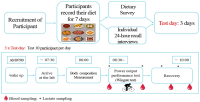
The aim of this study was to assess the eating habits of Korean wrestlers, and to explore the impact of differences in dietary intake on power output performance and blood lactate concentrations. Thirty adult wrestlers with more than seven years of experience each were included, grouped according to their competitive level (national, senior, and university team level). Participants recorded their dietary intake for seven days; nutritional analysis was performed using the CAN-Pro 4.0 software. After the nutritional survey, power output performance (Wingate test) was evaluated and blood parameters, including lactate concentration, were assessed. The wrestlers’ dietary assessments revealed differences in carbohydrate, protein, and fat intake among the groups, as well as differences in the peak power, mean power, and change in peak power, obtained from the Wingate test. Finally, the senior group had a significantly higher and lower lactate concentration than the university group immediately post training and 30 minutes post training, respectively. Follow-up studies should reveal more accurate associations between nutritional intake, nutritional quality, and performance. Finally, considering a study concerning nutrition and weight loss based on the results from this study, including not only wrestlers but also combat sport athletes will benefit nutrition education as well as athletes’ intake and performance.

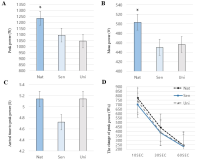
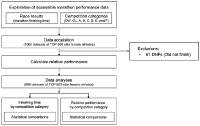
Purpose: We examined the importance of record competition in women’s marathon by comparing and analyzing the records of elite female marathoners for each competition they participated in. Methods: Data of the top 500 female marathon athletes in 2019 were collected from the World Athletics home page (www.worldathletics.org). All competitions approved by the World Athletics were given one of the following categories based on the scale of the competitions: OW, GL, A, B, C, D, E, and F. Race results, relative performances, and the categories of competitions in which subjects participated in were analyzed. Record comparisons were made using one-way ANOVA followed by the Bonferroni post hoc test. Results: There were significant differences in the average record of each category of competition. The average finishing time in GL was the fastest [2:30:26 (± 00:06:29)]. From A to F, average finishing time tended to increase from 2:32:38 (± 00:05:24) to 2:38:17 (± 00:08:27). The average finishing time in OW was the slowest [2:50:36 (± 00:10:48)]. Comparing the relative performances of the athletes in a year, relative performance was faster when participating in large scale international competitions (e.g., GL, A, B, and C), where the primary motivation of athletes is to achieve best records, than other smaller competitions (e.g., E and F), where athletes compete for ranks rather than records (p<.05). However, the relative performance in Olympic Games and World Championships (i.e., OW) was much slower than others (p<.05). Conclusions: These results are interpreted to mean that record competition is better for marathon performance.

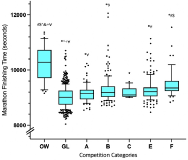
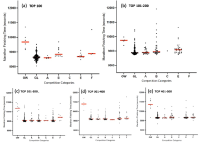

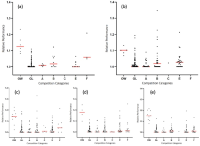
The purpose of this study was to investigate the effect of combined static and dynamic stretch as part of warm-up procedures on isokinetic strength, functional movement screen (FMS), flexibility, and agility in Korean national foil fencers. Twelve Korean fencers (mean age 29.3±3.6yrs, Career: 16.6±3.1yrs, Height: 171.4±9.5cm, Weight: 67.3±12.4kg) participated in this study (Male: 7, age 30.0±3.2yrs, Career: 16.7±2.2yrs, Height: 177.1±8.1cm, Weight: 75.1±9.9kg; Female: 5, age 28.4±4.4yrs, Career: 16.4±4.3yrs, Height: 163.4±3.9cm, Weight: 56.3±4.1kg). Fencers measured FMS, isokinetic strength of knee joint, flexibility, agility at pre (1-week) and post (4-week). Fencers performed a warm-up program three times a week for four weeks. As a results, FMS scores (11.8±2.3 to 14.4±1.6, p<0.05), strength of dominant knee flexors (115.5±26.0 to 126.0±26.6, p<0.05), change-step jump (66.0±6.8 to 69.4±5.6, p<0.05), trunk forward flexion (12.0±7.7 to 13.9±6.5, p<0.05) were significantly higher in post-test than pre-test, respectively. However, the results for front-rear step, trunk backward extension were not significant differences between pre-test and post-test. These results suggest that the fencing-specific warm-up program based on stretching is effective on strength of knee flexors, agility by increasing flexibility, improving stability, mobility.
The aim of the present study was to document the process of Long-term Athlete Development (LTAD) adoption by Canadian sport coaches, and to identify predictors of: 1) their attitude and intention to adopt such a social innovation, and 2) their LTAD adoption level. Using Rogers’ innovation diffusion theory, a survey of 499 Canadian coaches was conducted to identify the factors associated with three variables: coaches’ attitude towards LTAD, intention to adopt LTAD, and LTAD adoption status. 279 (56%)(35.4 ± 12.1 years) of them knew LTAD and filled out the entire questionnaire. Perceived knowledge of LTAD, its trialability, observability, intention to adopt, coaches’ certification level, and organisational support were the best predictors of LTAD model adoption level in coaching’ practice (R2=0.579, F9,184=28.32, p<0.001). Coaches in late-developing sports declared having greater knowledge of LTAD, more capacity for its implementation, and lower perceived complexity of application.
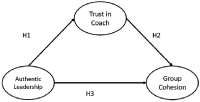
The purpose of this study was to analyze the relationship among players’ perceptions of authentic leadership, trust in coach, and group cohesion. Male college soccer players responded to questionnaire items about these three factors. A total of 249 survey data were analyzed by structural equation modeling. Authentic leadership had a significant positive relationship with trust in coach and group cohesion; trust in coach had a significant positive relationship with group cohesion; and trust in coach was a mediator in the relationship between authentic leadership and group cohesion. These findings suggest when coaches are authentic leaders, athlete and team outcomes may benefit.

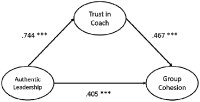

As the sport marketplace has become competitive, sport organizations are challenged to attract and maintain sport consumers. Using sport video games as a marketing communication strategy may be a good way to reach young sport consumers due to the popularity of sport video games(SVGs). Based on Kim and Ross’ findings (2006), it is believed that playing SVGs may foster a psychological connection with a sport team. The current study assumes the extent to which motives to play SVGs and a sense of presence contribute to explain a psychological connection with a sports team (i.e., internalization) based on the Fan Attitude Network (FAN) model (Funk & James, 2004). The internalization model of a sport object through sport video gaming is proposed based on the review of literature. The model assumes that motives to play SVGs and a sense of presence contribute to explaining what variables contribute to a sport identity. The purpose of the study is to understand the influence of motives to play SVGs and a sense of presence on a sport identity. A theoretical model depicting the relationship between motives to play SVGs and a sport identity, the relationship between a sense of presence and a sport identity, and the interaction effect between motives and a sense of presence on a sport identity was proposed. Testing the proposed model would contribute to the understanding of what drives sport video gamers to facilitate personal connections with their favorite teams and guide implications for marketing communication practice.

The purpose of this study was to investigate the characteristics of Korean female secondary PE teachers’ voluntary professional development(PD) activity participation in relation to female PE teachers’ perceived professional identity. Data were collected from online questionnaires (n=107) and in-depth interviews (n=15) with female secondary PE teachers. Findings revealed that female PE teachers’ voluntary professional development activities were characterized as: (a) prevalence in sport skill development activities in order to overcome relatively a low level of sport skills than that of male PE teachers, (b) dominance of self-directed learning activities with the Internet search or reading, and (c) seeking ideal mix of theory and practice by participating in teacher learning communities. Female PE teachers’ voluntary PD participation was related to their notion of PE subject as sport skills-centered subject, relatively weak professional identity due to lack of sport skills compared with male teachers, and perceiving teacher learning community as a viable learning context to support their everyday pedagogical PE practice.
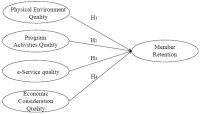
COVID-19 continues to represent the challenge to Taekwondo (TKD) schools. TKD schools have been closed and faced with decreasing participants due to the Pandemic. The purpose of this study is to examine the extent to which service quality factors predict member intention for renewal in TKD schools. The target population evaluated for this study consisted of individuals aged at least 18 years or older who had attended a TKD schools. This study conducted for TKD members in the U.S.. A total of 159 participants were recruited via both in-person and online surveys. This study revealed that TKD members in U.S. of various demographic backgrounds had different perceptions of service quality factors that affected their attendance at TKD schools. The findings of this study will indicate the impact on the satisfaction of various TKD programs and maintenance of membership.

Though the role of emotion has been largely acknowledged across most consumer settings, only recently has this interest transferred to the various contexts in which sports are consumed. The purpose of the present research is to highlight the role of emotions during the viewing of televised sports programming. Across two studies, the manifestation of emotional arousal is empirically established. Additionally, the emotional valence (i.e., the extent to which a stimulus is perceived as affectively positive, neutral, or negative) of marketing stimuli are assessed. A methodology for measuring baseline levels of emotional valence for commercial advertising is outlined. Study 1 is presented in which empirical support is established for the fleeting influence that live sports consumption has upon emotional arousal. This is followed by a review of Study 2, which establishes a methodology for measuring the emotional valence perceived by consumers for embedded commercial advertising. Finally, the practical and research implications of these findings are discussed.
While participating in leisure activities received its notion to help international students’ adjustment process, research regarding the effect of sports spectatorship is lacking. The main purpose of this study is to fill in the gap of the effect of being fans of college sports by examining how international students can also benefit from being fans of college sports for their acculturation. The analysis with 94 international students revealed that their team identification and social activity participation had a significant statistical causal relationship towards acculturation. The study’s implications included utilizing sports spectatorship as a future acculturation strategy for international students.